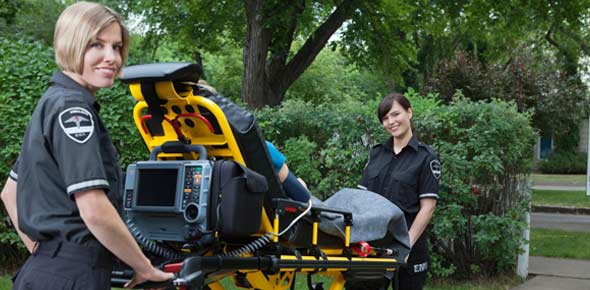EMT Lesson One Roles & Responsiblities

This quiz covers introductory material found in the National EMT course.
- 1.
What is the national organization responsible for organizing training and testing basic EMTs?
- A.
National Association of EMTs
- B.
National Medical Directors Association
- C.
National Registry of EMTs
Correct Answer
C. National Registry of EMTsExplanation
The National Registry of EMTs is the correct answer because it is the national organization responsible for organizing training and testing basic EMTs. They set the standards for EMT education and certification, and ensure that EMTs are properly trained and qualified to provide emergency medical care.Rate this question:
-
- 2.
What EMS certification levels are offered on a national level?
- A.
First Responder, EMT-Basic, EMT-Intermediate, EMT-Paramedic
- B.
Emergency Helper, EMT-Basic, EMT-Intermediate, EMT-Paramedic
- C.
First Responder, EMT-Basic, EMT-Advanced, EMT-Paramedic
Correct Answer
A. First Responder, EMT-Basic, EMT-Intermediate, EMT-ParamedicExplanation
The correct answer is First Responder, EMT-Basic, EMT-Intermediate, EMT-Paramedic. These are the different levels of EMS certification that are offered on a national level. First Responder is the basic level, followed by EMT-Basic, EMT-Intermediate, and EMT-Paramedic, which is the highest level of certification.Rate this question:
-
- 3.
Medical Protocols are medical direction authorization to perform a procedure in the field without contacting medical control.
- A.
True
- B.
False
Correct Answer
B. FalseExplanation
Protocols are a list of steps in administering care for a particular medical problem.Rate this question:
-
- 4.
Authorization from medical direction to conduct an emergency medical procedure in the field without contacting a hospital or medical control is called what?
- A.
Intervention Priority
- B.
Standing Orders
- C.
Protocols
Correct Answer
B. Standing OrdersExplanation
Standing orders refer to the authorization given by medical direction to conduct emergency medical procedures in the field without the need to contact a hospital or medical control. This allows healthcare providers to quickly and efficiently provide necessary medical interventions based on predetermined protocols and guidelines. Standing orders ensure that critical care can be provided promptly in emergency situations without the delay of seeking approval from medical control or a hospital.Rate this question:
-
- 5.
Your patient was involved in a motor vehicle accident with major trauma and appears to being going into shock. Your priority would be to get your patient immediately to the closest hospital.
- A.
True
- B.
False
Correct Answer
B. FalseExplanation
Major trauma patients should be transported to a trauma center.Rate this question:
-
- 6.
Which statement best describes the duties of an EMT-Basic?
- A.
Patient Assessment, Endotrachel Intubation, and bandaging/splinting
- B.
Treating Medical Emergencies with Oxygen, Triage, and CPR
- C.
Administering Oxygen, Initiating IV therapy, and CPR
Correct Answer
B. Treating Medical Emergencies with Oxygen, Triage, and CPRExplanation
The duties of an EMT-Basic involve treating medical emergencies with oxygen, triage, and CPR. This means that they are responsible for providing immediate medical care to patients in emergency situations, assessing their condition, and providing necessary treatment such as administering oxygen and performing CPR. Triage is also an important duty, as EMT-Basics need to prioritize patients based on the severity of their condition. This answer accurately describes the primary responsibilities of an EMT-Basic.Rate this question:
-
- 7.
Which statement concerning EMT duties is incorrect?
- A.
EMTs may take chances and risk their lives if patients are in danger.
- B.
EMTs have a duty to protect themselves.
- C.
EMTs have a duty to protect others.
Correct Answer
A. EMTs may take chances and risk their lives if patients are in danger.Explanation
The incorrect statement is that EMTs may take chances and risk their lives if patients are in danger. EMTs have a duty to protect themselves and others, but they are not allowed to take unnecessary risks that could endanger their own lives. The safety of the EMT is important in order to effectively provide care for patients.Rate this question:
-
- 8.
Which of the following might not be considered part of an EMS system?
- A.
Physician Medical Directors
- B.
Continuing Education Programs
- C.
Both of the above are components of an EMS system.
Correct Answer
C. Both of the above are components of an EMS system.Explanation
Both Physician Medical Directors and Continuing Education Programs are considered part of an EMS system. Physician Medical Directors play a crucial role in providing medical oversight and guidance to EMS personnel. They help develop protocols, review cases, and ensure quality care. Continuing Education Programs are essential for maintaining and updating the knowledge and skills of EMS providers. They offer ongoing training and education to ensure that EMS personnel are up-to-date with the latest advancements and best practices in the field.Rate this question:
-
Quiz Review Timeline +
Our quizzes are rigorously reviewed, monitored and continuously updated by our expert board to maintain accuracy, relevance, and timeliness.
-
Current Version
-
Mar 20, 2023Quiz Edited by
ProProfs Editorial Team -
Jul 25, 2011Quiz Created by
Jimbecka
 Back to top
Back to top


